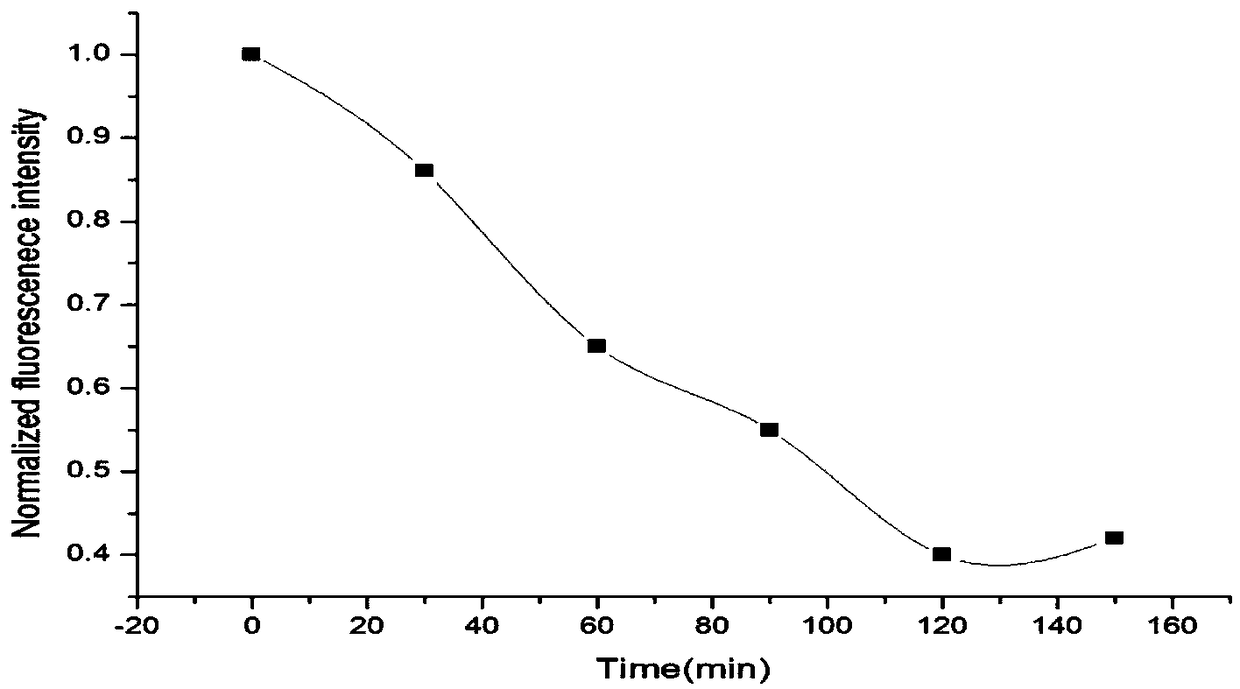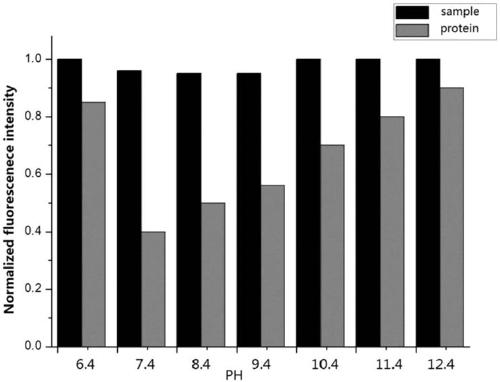Method for preparing and marking bcl-2 (b-cell lymphoma-2) protein of oral squamous cell carcinoma cells through imine acridine fluorescent probe
A technology of bcl-2 and fluorescent probes, applied in the direction of fluorescence/phosphorescence, chemical instruments and methods, luminescent materials, etc., can solve the problems of short fluorescence lifetime, poor photostability, and limited applications, and achieve simple synthesis routes and excellent reaction conditions Gentle, easy post-processing results
- Summary
- Abstract
- Description
- Claims
- Application Information
AI Technical Summary
Problems solved by technology
Method used
Image
Examples
Embodiment 1
[0029] Example 1: Synthesis of small molecule fluorescent probes for protein labeling
[0030] (1) Synthesis of intermediate compound I:
[0031]
[0032] Add 3 mmol of acridone into a two-necked flask equipped with a condenser tube and a stirring bar, and fill with N 2 , add 6ml SOCl in nitrogen atmosphere 2 , reflux at 80 °C for 3 h, after the reaction is completed, cool to room temperature, slowly drop the reaction solution into ice water while stirring, mix ice, concentrated ammonia water and chloroform (mass ratio: 1:1:1) solution was added to the above liquid, the chloroform layer was separated, dried (anhydrous magnesium sulfate), and filtered to obtain a light yellow liquid, which was purified by column chromatography with ethyl acetate: petroleum ether volume ratio = 1:3 to obtain white needle crystals , an intermediate compound I with strong fluorescence, with a yield of 86%.
[0033]
[0034] Dissolve the intermediate compound I (9-chloroacridine) in phenol...
Embodiment 2
[0038] Example 2: Fluorescence changes after fluorescent probes and bcl-2 protein labeling of oral squamous cell carcinoma cells
[0039] The Tris-HCl solution was prepared to be 0.05 mol / LPH=7.4 (with a concentration of 0.1 mol / L NaCl solution). Add 1 ml of Tris-HCl solution to 4 ml of EP tube, the concentration of 1 ml of Example 1 is 1 × 10 -5 mol / L solution of fluorescent compound (fluorescent probe III) and 1 ml of ultrapure water were prepared as a control solution, and the added concentration was 1×10 -5 The fluorescence intensity after mol / L bcl-2 protein was compared. Using a 2mm quartz cuvette, after repeated measurements, the excitation wavelength of 260 nm is the best, the sensitivity of the instrument is adjusted to 1, the wavelength range is between 285 and 500 nm, the excitation and emission slits are 5 nm, and the voltage is 500 V. The scanning speed was 1200 nm / min, and the change of the fluorescence intensity of the compound (fluorescent probe III) was me...
Embodiment 3
[0041] Embodiment 3: the kinetics of fluorescent probe and bcl-2 protein reaction
[0042]The Tris-HCl solution was prepared to be 0.05 mol / LPH=7.4 (with a concentration of 0.1 mol / L NaCl). Add 1 ml Tris-HCl solution to 4 ml of EP tube, the concentration prepared in 1 ml of Example 1 is 1×10 -5 mol / L solution of fluorescent compound (fluorescent probe III) and 1 ml concentration of 1×10 -5 mol / L bcl-2 protein. Placed in a 37°C incubator for incubation. get figure 2 , the results showed that the fluorescence intensity changed most obviously when the time reached 120 min, and the fluorescence intensity did not change much when the time was extended, so the best time for the fluorescent substance (fluorescent probe III) to bind to the protein was 2 h.
PUM
 Login to View More
Login to View More Abstract
Description
Claims
Application Information
 Login to View More
Login to View More - R&D Engineer
- R&D Manager
- IP Professional
- Industry Leading Data Capabilities
- Powerful AI technology
- Patent DNA Extraction
Browse by: Latest US Patents, China's latest patents, Technical Efficacy Thesaurus, Application Domain, Technology Topic, Popular Technical Reports.
© 2024 PatSnap. All rights reserved.Legal|Privacy policy|Modern Slavery Act Transparency Statement|Sitemap|About US| Contact US: help@patsnap.com










